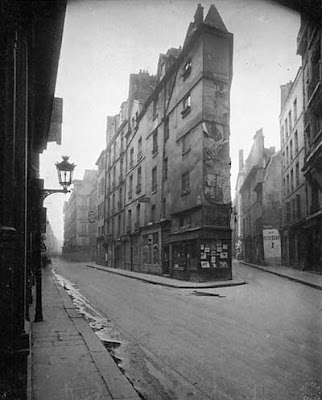 Borges's first book was a collection of poems entitled Fervor de Buenos Aires, published in 1923.
Borges's first book was a collection of poems entitled Fervor de Buenos Aires, published in 1923. One might expect the title to refer to the "fervor" or the hustle and bustle of a city undergoing rapid expansion in the early years of the twentieth century: thanks to mass immigration, Buenos Aires grew by 75% during this period (Beatriz Sarlo, Una modernidad periférica 18). But Borges's city is strangely subdued and depopulated. Practically every other poem has a reference to "shadow" ("the bank of shadow" [39], "fear of the shadows" [57]) or to "ash" ("a little ash and a little glory" [44], "between the ashes and the fatherland"), not to mention death (the poems "Remorse for Any Death" [53], "Inscription on Any Tomb" [55]), boredom (52), and solitude (67) and so on.
If this is the modern (or even the modernist) city, more than anything else it reminds one of French photographer Eugène Atget's famous portraits of deserted Parisian streetscapes. And if Borges is an urban flâneur, he is one who avoids the city-center streets, "unpleasant because of all the crowds and fuss." He prefers rather to wander the suburbs and indeed the very edge of the city, where the deserted lanes are "full of promise for the man on his own" (37).

And yet Borges has told us that where there is one there are always also at least two. "I am alone and I am with myself" as he puts it here (65). Or even many: his is a "solitude populated like a dream" (69). One is already quite enough of a crowd, because every "one" (or everyone) is divided, split, multiple.
And so it is too with Fervor de Buenos Aires. This is a book that is many, written by more than one. For though it was Borges's first book, he also continually returned to it: as Kate Jenckes observes, there are at least four versions of the text (from 1923, 1943, 1969, and 1974), all of which are significantly different and none of which can be regarded as fully definitive (Reading Borges After Benjamin 7 and 141n6). The one I am reading is from the Obras completas (though again there are many iterations of Borges's "Complete Works," none of which are complete; mine is from 1992). This comes with a prologue dated August 1969 in which Borges admits to having edited some of the poems but claims that he
felt that the boy who wrote the book in 1923 was already essentially--what does "essentially" mean?--the gentleman who now either resigns himself to what it says or corrects it. We are the same; we are both skeptical of failure and success, of literary movements and their dogmas; we are both devotees of Schopenhauer, Stevenson, and Whitman. As far as I am concerned, Fervor de Buenos Aires prefigures everything that I would do afterwards. (33)It's worth mentioning, though, that in the original Spanish that final phrase ("todo lo que haría después") could just as easily be translated "everything that he would do afterwards." Borges and I (and he): which is which? Which wrote this book, and which wrote what came after?
Equally, if we come to this, Borges's first book, to understand the origins of his writing career, which version should we be reading? Is what I have read (and quoted), revised in 1969, really the "origin"? Even the order of the collection varies according to the date of publication. Beatriz Sarlo makes much of the fact that the first poem to appear is "La Recoleta," about the Buenos Aires cemetery of that name (Una modernidad periférica 18). But as Jenckes points out, in other editions (including the one I am reading) this is actually the second poem printed, not the first (140n3). Quite literally, the point of origin is murky and unstable. We are starting our reading of Borges here (if we ignore for the time being the fact that we already started), but we can't be entirely sure as to where this "here" is. As soon as we reach out to it, it divides and multiplies.
Should this slipperiness be cause for concern? Borges is in some ways essentially slippery. Note above, for instance, that at the very moment that he justifies his editorial interventions by claiming that he and his younger self are "essentially" the same, he also has to question what is meant by "essentially." He states and undercuts his case at one and the same time. For after all, was the boy ever even "essentially" the same as himself at the time: "I am alone and I am with myself" (65).
For Borges, the true mystery is not this endless division and uncertainty. Time passes, things change, moment to moment everything is up in the air; neither language nor reason can hold things still within their prisons of representation or categorization. I is always another. It could not be otherwise. No, the real surprise is that despite all this mutability and malleability, some things somehow do seem to remain the same. It may be mere illusion or habit (though what could be less illusory than habit?), but we do think--or better, as Borges puts it, feel--that we incarnate some kind of singularity that is more or less the same today as it was yesterday or as it was (in Borges's case) 46 years previously. Hence then the
wonder in the face of the miracleThis surely is the Spinozan conatus to which "Borges and yo" already made reference: the striving to endure within what is otherwise endless flux, bubbling fervor.
that despite the infinite play of chance
that despite the fact that we are but
drops in Heraclitus's river,
something still endures within us:
unmoved. (50)
